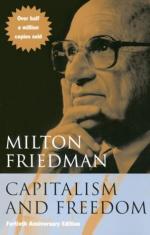
|
| Name: _________________________ | Period: ___________________ |
This test consists of 15 multiple choice questions and 5 short answer questions.
Multiple Choice Questions
1. According to Friedman, what is one major cost of the extension of governmental welfare activities?
(a) Lower productivity of labor.
(b) Decline in private charitable activities.
(c) Higher taxes with low results.
(d) Increased regulation of private organizations.
2. Which of the following is not an example of social welfare?
(a) Public housing.
(b) Medicare.
(c) Occupational licensure.
(d) Minimum wage laws.
3. Instead of reducing inequality, Friedman states the income tax has favored ______.
(a) The growth of labor unions.
(b) The growth of large corporations.
(c) Subsidies for farmers.
(d) Public housing.
4. To what previous restrictions on labor does Friedman compare licenses?
(a) Unions and organizations.
(b) Guilds and castes.
(c) Clubs and coalitions.
(d) Fraternities and sororities.
5. In Chapter 10, The Distribution of Income, what was the chief characteristic of progress and development over the past century?
(a) Increae in leisure time.
(b) Advances in entertainment.
(c) Advances in technology.
(d) Advances in education.
6. What two professions does Friedman compare to support his claim on the harm it does when people are unable to find mutually acceptable contracts?
(a) Doctor and priest.
(b) Baseball player and basketball player.
(c) Teacher and professor.
(d) Blues singer and opera singer.
7. According to Friedman, Social security measures were enacted to make receipt of assistance a matter of ______.
(a) Right.
(b) Principle.
(c) Authority.
(d) Paperwork.
8. Forming a list of who engages in what is known as ______.
(a) Registration.
(b) Licensing.
(c) Organizing.
(d) Listing.
9. What is one method that governments have used to alter the distribution of income?
(a) Income taxation.
(b) Social welfare.
(c) Selling bonds.
(d) Real estate law.
10. One threat Friedman believes to the preservation and expansion of freedom is ______.
(a) The Kremlin.
(b) Economic uncertainties.
(c) Cuba.
(d) An uneducated workforce.
11. What is the key issue for Friedman with annuities?
(a) Compulsory purchase of annuities.
(b) Fulfilling the demand for annuities.
(c) Distributing the profits of annuities.
(d) Government issuance of annuities.
12. What is the term for laws that forbid membership in a union a requirement for employment?
(a) Right to work laws.
(b) Fair labor laws.
(c) Employment standards laws.
(d) Anti-union laws.
13. According to Friedman, a liberal will welcome measures that promote what?
(a) Wealth and freedom.
(b) Power and politics.
(c) Freedom and equality.
(d) Elimination of poverty.
14. Another threat for Friedman to the preservation and expansion of freedom is:
(a) An internal threat of labor unions.
(b) An internal threat of licensure requirements.
(c) An internal threat of government regulation.
(d) An internal threat of unfair political practices.
15. Friedman gives the following examples of the negative effects of government intervention except ______.
(a) Religious freedom acts.
(b) Housing programs.
(c) Regulation of the railroads.
(d) Farm subsidies.
Short Answer Questions
1. Friedman gives examples of successful government intervention except ______.
2. What is one example of a government supported monopoly?
3. According to Friedman, what are licenses restrictions on?
4. Friedman would agree that racism is ______.
5. In Chapter 12, The Alleviation of Poverty, what two things does Friedman say a person cannot be at the same time?
|
This section contains 506 words (approx. 2 pages at 300 words per page) |

|




